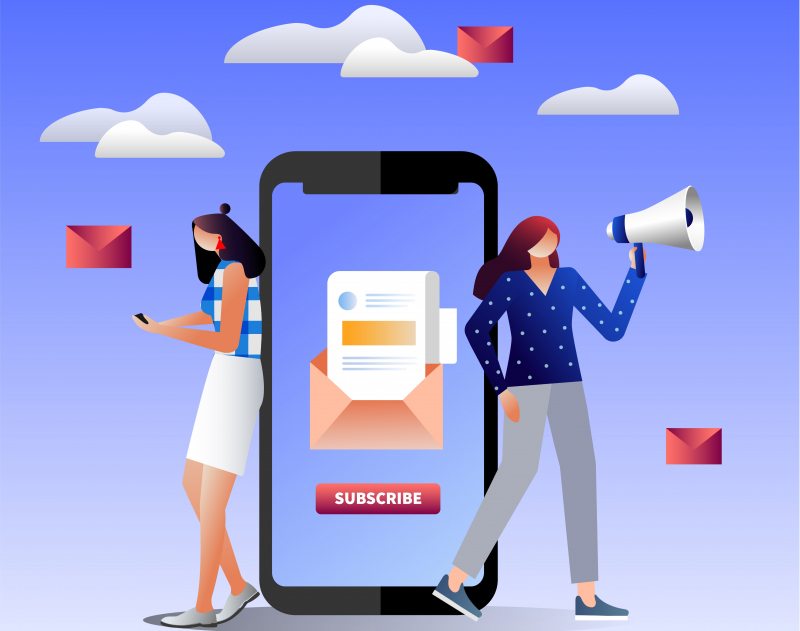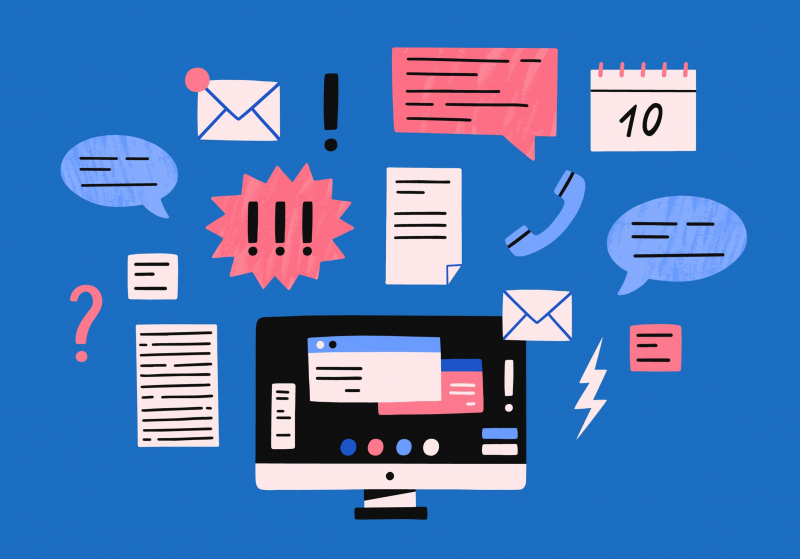Is email marketing effective?
Email marketing gets buried every year: people say that it’s going to be superseded by SMM, social media mailouts, chatbots and so on. But experience shows that mailout continues to be an effective sales tool with up to 10% conversion; what’s most important here is to set it up right.
-
Create a customer profile
As in all kinds of marketing, the first step is identifying the target audience and creating a generalized customer profile – some sort of a client avatar. This stage is very important, because right from the start, we have to understand whom we’ll be talking to, in which language, and on which topics. This profile shouldn’t be out of touch with reality, representing our dream client. What we need is a realistic understanding of consumers’ interests, tastes, habits, preferences, purchasing power – all this can be found out by talking to managers and salespeople, who are in direct contact with clients.
-
Don’t beat around the bush
The average time for viewing an email is about 10 seconds. In this short period of time, it’s necessary to not only catch the reader’s attention, but also communicate your main message. Usually, emails are built on the principle of a reversed pyramid: the biggest topmost module houses the most important information (what, where, when), followed by smaller details, and culminating in additions and clarifications in small print in the very end. It’s better to use more images and less text, though this rule depends on the purpose and function of each specific email. But for regular letters with announcements of sales, new additions and discounts, events and so on, the aforementioned model proves the most effective.

-
One email – one goal
This is the most universal and important rule. All the necessary information should fit on one screen and contain one message. If we simultaneously have several announcements or offers, it’s better to break them down into several separate emails.
From my experience it could be said that receivers’ involvement is higher in creative mailouts that play off of current affairs and events in the world, topics that are popular in the media. It’s also advantageous to include some interesting facts at various levels of usefulness and informativeness. This serves as a mold-breaker – as the customer expects to be actively persuaded to buy something and nothing else – and nudges them to skim the text with more attention.
-
Segment your client base
For a mailout to sell, first and foremost you have to segment and personalize the existing client base (for example, to those who only buy discounted items or are interested in a specific type of goods). Then pick relevant offers for each of these target audiences. Regularly test different hypotheses: change the time and frequency of the mailout, experiment with email topics. From time to time, make sure to gather feedback, launch surveys in the vein of “how often do you want to get our emails and on which topics”. Usually, these questions are responded to by less than 10% of clients, but this provides an essential body of data on how best to organize your work.
Email strategy: the main steps

An email strategy cannot exist in isolation from the general business promotion strategy. In other words, it’s crucial, from the very get go, to decide on a general business goal, the marketing tasks, and communication channels with the help of which these tasks can be solved.
For instance, if you have a general goal of growing your sales, your marketing goal will be to attract new clients and increase customer loyalty to the brand. Communication goals here will consist of creating demand in the product, increasing its recognition, stimulating recurrent purchases.
A standard email marketing strategy includes:
-
a welcome series (when a customer has just subscribed),
-
a content mailout,
-
periodic promotional offers,
-
reanimation series (when a customer loses interest),
-
and cross-channel promotions (chatbots, “visit our social media”).
Communication with clients can be divided into several levels, the first one being the awareness level. It is reached with promotional posts on social media, YouTube ads, contextual advertising and advertising integrations, getting people to participate in free webinars and workshops.
The second and higher level is familiarizing your clients with the company through its blog, social media accounts and – what’s most important for us – mailouts. This is the stage for launching the first welcome series.

The duration of the welcome series cycle depends on the specifics of your business. For example, online purchases most often are emotions-based, which is why a relevant mailout should aim at nudging a client to complete the purchase as soon as possible, when they haven’t yet lost interest and motivation, with a couple of push notifications with discounts, promo codes, last-minute offers.
Meanwhile, if you’re setting up a mailout for a consulting bureau or a design studio, your welcome series can consist of dozens of letters which zoom in on the company’s expertise and earn the client’s trust.
The next level of communication is conversion of sales and client retention. This includes the main body of mailouts aimed at increasing customer loyalty and promoting repeat purchases (through private sales, invitations to events, useful resources), triggered emails (asking to leave a review or recommendation), reanimation series (if a client stops reacting).
Connecting with clients through mailouts is very important – if they have a clear understanding of what exactly you do for them, what you do in terms of their convenience and benefits, they will be more loyal to your company.
How to assemble a client base

The main question is: to whom exactly should we send our emails? How to assemble a database of potential clients and get their email addresses?
If we’re talking about an internet business, it’s pretty simple. For example, we have a landing page – a point of entry for traffic from social media, contextual advertising campaigns, engine searches, offline advertising and so on. The best-case conversion for such a page is 10%. In order to improve it, you could use a subscription form or a lead capture form. It’s believed that the most effective way is a call for action: “get a personal discount”, “learn more”, clicking on which opens a form with email address, phone number, etc.
Another popular option are pop-ups. But there are a couple of nuances: if a pop-up window was to appear right when a client opens the company website, this could be very annoying. It’s best to time its appearance to a client’s actions: for example, if they are making a beeline for specific items and are already ready to pay, the window shouldn’t appear until they complete the purchase. If, however, they aren’t looking for specific items but are just familiarizing themselves with the shop’s product range, here a pop-up can be used to offer a discount for subscription or a promo code. A successfully implemented pop-up window could gather up to 10% of traffic, increasing the website’s overall conversion to 20%.

You can also garner email addresses through single-page promotional landings. This method works when you’re preparing a specific offer for a specific audience, for example marketing courses – interested users get to a single-page landing via marketing traffic and leave their contact information. Such a mailout will hands-down have a high conversion because people subscribe to it consciously, knowing that they will be interested in the content on offer.
Client databases could also be quickly assembled through social media leads. This is a pre-filled out application form which only asks users to input their email and phone number – without having to leave the Facebook or VK newsfeed. Facebook and Instagram even offer integration with the mailout service Mailchimp, meaning that you can set up social media leads-based mailouts automatically.
Another tried-and-true way to get hold of a client’s email is to ask them to fill out a questionnaire when registering for a discount card. But in this case, you absolutely have to keep in mind that this action is regulated by law – which means that you need to obtain the client’s consent to cross-border transfer of personal data.
Legal regulation of mailouts

It’s crucial that you abide by law when drawing up marketing mailouts in general. In terms of the legislation and internal rules of internet providers, a mailout is considered a marketing one if it is sent to more than 20 email addresses – until that, it remains in the personal correspondence category.
Mailouts are regulated by the federal law “On advertising” and the Russian Federation law “On personal data”. To observe these laws, you have to get a client’s clear, 100% consent to receiving commercial information, and also to the processing and use of their personal data. For this, you need to preliminarily draw up the terms of use and privacy policy which will cover the ways you deal with personal data, as well as what information you will send to users. A basic template of privacy policy can be found, for example, here (in Russian). You also need to register as a data operator with the Federal Service for Supervision of Communications, Information Technology and Mass Media (Roskomnadzor).
International market has its own personal data laws. For example, in the EU it’s GDPR – the General Data Protection Regulation. It stipulates that you have to obtain a client’s consent for emailing, calling or texting them separately, and also indicate exactly which types of personal data are collected, the time for which they’re stored and the ways in which they are used.
Every internet provider and email service also has its own internal rules, a failure to abide by which could risk your mailout being marked as spam. In order to make sure that you’re not violating anything, and bump up customer loyalty along the way, it would be ideal if you made your first email a confirmation of the user’s consent to subscribe.
Domain reputation

All commercial mailouts should come from your website’s domain and not just some random address, and this domain should have a good reputation. You can’t straight-up start with a mailout to several thousand people – such emails are guaranteed to be blocked by providers’ spam filters. You should start with several dozen recipients, gradually increasing this number to hundreds and only then thousands – this is called “domain warm-up”.
Reputation consists of a wide range of different indicators: how often people open your emails or delete them without looking, report them or mark them as spam and so forth. As the number of deleted unread emails grows, the reputation will deteriorate. If users don’t open your emails and you don’t delete them from your database and keep sending them mailouts with the same frequency, your reputation will plummet, and your mailout won’t even send to those who open the emails. It’s possible to extricate a badly-reputed domain from spam, but it requires a lot of manual work and takes a lot of time.
You can conveniently monitor your reputation via free resources called Postmaster Tools, which are offered by major email services such as Google, Yandex, and Mail.ru. Gmail, for example, allows you to see detailed statistics not only on the domain as a whole but also on each specific email – how many people opened and read it, how many people deleted it without opening or marked it as spam.
To create and set up mailouts, it’s best to use ready-made tools such as Mailchimp: these allow you to create a domain, the landing pages and lead capture forms, launch social media advertising, and develop a specific design for the emails and their content.
The workshop was organized by the Inter-University Entrepreneurship Club. Its full recording is available here (in Russian).





